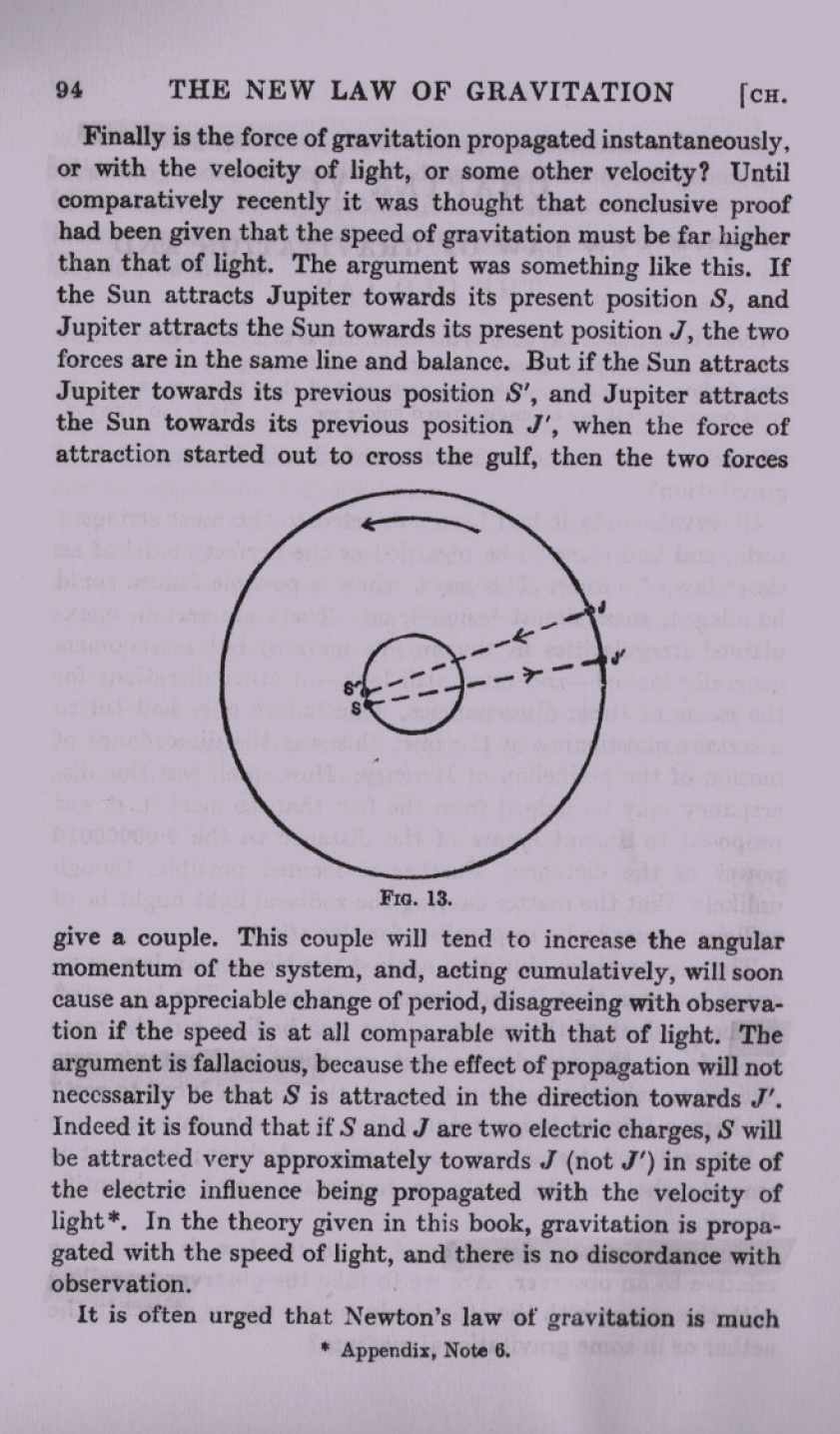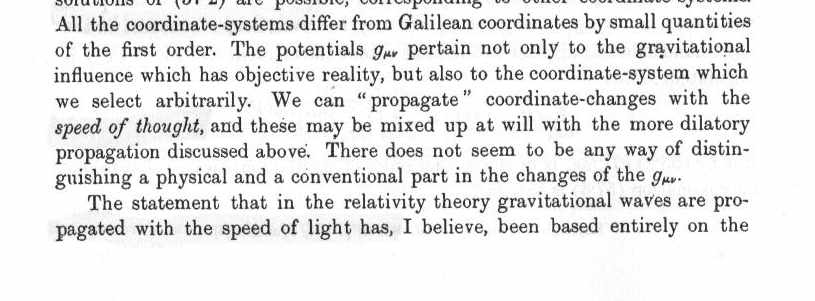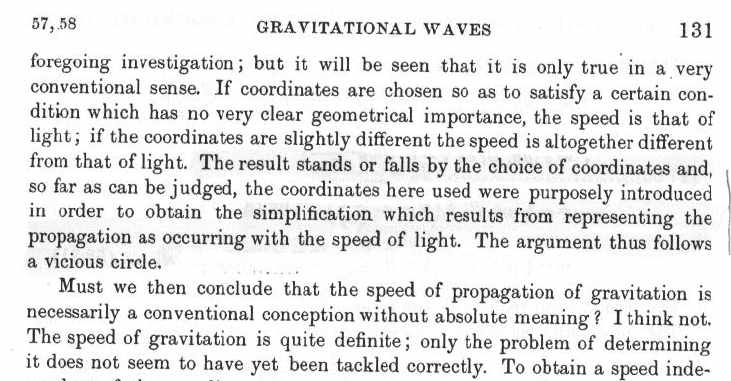Eddington on the
Speed of gravity in General Relativitylast modified 6-6-2020
Arthur Stanley Eddington was a very accomplished
and brilliant British physicist, mathematician, and astronomer. Shortly
after Einstein's theories of Special and General Relativity were
published, Eddington authored two books on the subject:
Space, Time and Gravitation
(1920) and
The
Mathematical Theory of Relativity
(1923). The presentation below concerns only what these two
books
have to say about how fast the force of gravity is propagated.
Eddington
points out that it was long thought that the speed of gravitational
force was far higher than that of light. The historical argument was
that if gravity was propagated at the speed of light, there would be a
"force couple" that develops between the present position of Jupiter
and the so-called "retarded position" of Jupiter.
This would result in an
alteration of Jupiter's orbit around the Sun which would be easily
observed
over time. But no such alteration has been observed. Hence,
something is wrong with the argument.
Eddington's belief was
that the gravitational force acts much like that of electrical forces
between charges. As the footnote referenced on the page below explains
"To the first order of
vr/C,
the denominator is equal to the
present
distance
r,
so the expression reduces to
e/r
in spite of the time propagation. The foregoing formula for the
potential was found by
Lienard and Wiehert."
In other words, the electrical force always points directly to either
charge regardless of their motion. There is therefore no applicable
"retarded position", and therefore no force couple. (See
The
Speed of Electric Fields for an illustrated
explanation.)
Eddington
still assumes, strangely, that gravitational force is propagated at the
speed of light, and likewise for forces between electric charges.
A. P. French commits the same error as
shown in
The
Speed of Electric Fields
. Evidently, even brilliant minds found instantaneous
action-at-a-distance ("non-locality") too inconceivable to take
seriously, whether in the 1920s or the 1960s.
 Space, Time and
Gravitation An Outline of the General Relativity Theory
Space, Time and
Gravitation An Outline of the General Relativity Theory,
A. S. Eddington (1920; reprint 2013) p.94
Eddington's
second book (below) shows that the speed of gravity in General
Relativity depends on the choice of a coordinate system. In Einstein's
General Relativity "the
coordinates used were purposely introduced in order to obtain the
simplification which results from representing the propagation as
occurring with the speed of light." But the choice is arbitrary and
"The argument thus follows a vicious circle."
Eddington
says that "the speed of gravitation is quite definite". But
in
the 1920s no actual laboratory experiments had been done to measure the
speed. Hence, the speed was still an open question. Einstein
arbitrarily chose the speed of light to simplify his theory.
The Mathematical Theory of Relativity
,
A. S. Eddington (1923; reprint 2017 by Forgotten Books) p130-131
The
take-away from
all this is that there is really nothing in Einstein's General
Relativity that "proves" or "requires" the speed of gravity to be the
same as the speed of light. Indeed, recent investigations indicate that
the speed of gravity is very much faster than the speed of light and is
probably instantaneous ("non-local").
Links:
https://www.britannica.com/biography/Arthur-Eddington
https://en.wikibooks.org/wiki/Electrodynamics/Lienard-Wiechert_Potentials
http://www.pandualism.com/c/coulomb_experiment.html :
- Experimental Clarification of Coulomb-Field Propagation
Superluminal information transfer confirmed by simple experiment
Wolfgang G. Gasser (May, 2016)
PDF Version – Kurze Version auf Deutsch
Abstract
| A
simple experiment has been performed in order to measure propagation
speed of the electric field. The results show that the Coulomb
interaction propagates substantially faster than at speed of light c. |

Fig. 1: Schematic of the experiment
The
experiment uses a spark gap between two conducting spheres acting as
capacitors of opposite electric charge. After spark-formation, this
rapidly collapsing dipole field is measured by an oscilloscope
connected via probes to conducting detector-spheres. Whereas the mutual
distance between the detector spheres connected to the oscilloscope
remains at Δx = 1.65 m (from left probe tip to right probe tip),
different distances from the spark-gap have been measured. |
Tab. 1
The
measured propagation speeds v = Δx/Δt from the left to the right
detector sphere, with Δt averaged over each five measurements, range
from around 1.4 c to 5 c, and show a dependence on the distance from
the spark gap. The
by far simplest explanation of the experiment is the hypothesis that
the Coulomb interaction conforms to Coulomb, who assumed instantaneous
interaction at a distance. The dependence of the measured propagation
speed on the distance of the measurement setup from the spark gap is
explained by dissipative losses and "image charge" complication,
leading to electric currents in the ground and the walls. Credits: http://www.pandualism.com/d/instantaneous.html http://www.pandualism.com/c/coulomb_experiment.html |
- Experimental Evidence of Near-field Superluminally Propagating Electromagnetic Fields
William D. Walker(Submitted on 6 Sep 2000)
A
simple experiment is presented which indicates that electromagnetic
fields propagate superluminally in the near-field next to an
oscillating electric dipole source. A high frequency 437MHz, 2 watt
sinusoidal electrical signal is transmitted from a dipole antenna to a
parallel near-field dipole detecting antenna. The phase difference
between the two antenna signals is monitored with an oscilloscope as
the distance between the antennas is increased. Analysis of the phase
vs distance curve indicates that superluminal transverse electric field
waves (phase and group) are generated approximately one-quarter
wavelength outside the source and propagate toward and away from the
source. Upon creation, the transverse waves travel with infinite speed.
The outgoing transverse waves reduce to the speed of light after they
propagate about one wavelength away from the source. The inward
propagating transverse fields rapidly reduce to the speed of light and
then rapidly increase to infinite speed as they travel into the source.
The results are shown to be consistent with standard electrodynamic
theory.
Comments:17
pages, Presented at Vigier III Symposium: Gravitation and Cosmology,
Berkeley, California, USA, August 21-25, 2000Subjects:
General Physics (physics.gen-ph); Classical Physics (physics.class-ph) Cite as:arXiv:physics/0009023
[physics.gen-ph] (or
https://arxiv.org/abs/physics/0009023v1 [physics.gen-ph] for this version)
(BF note 1-31-20: The change in speed of the waves within one wavelength of distance sounds a lot like evanescent waves
that are being produced along with the usual electromagnetic waves.
This should have important practical and theoretical implications.)



